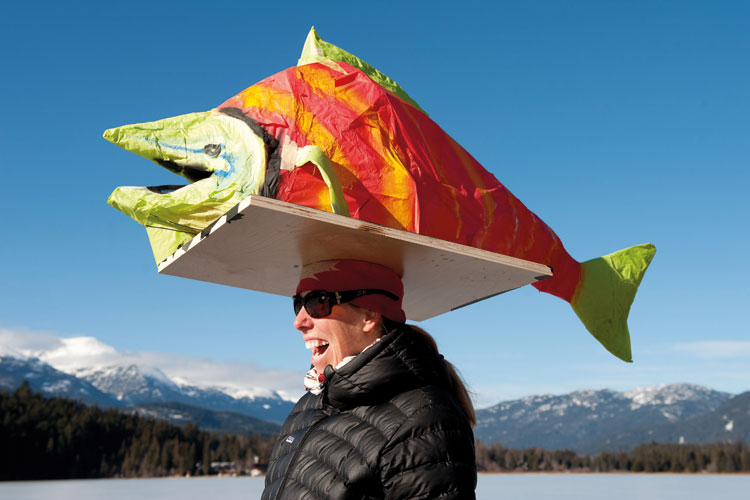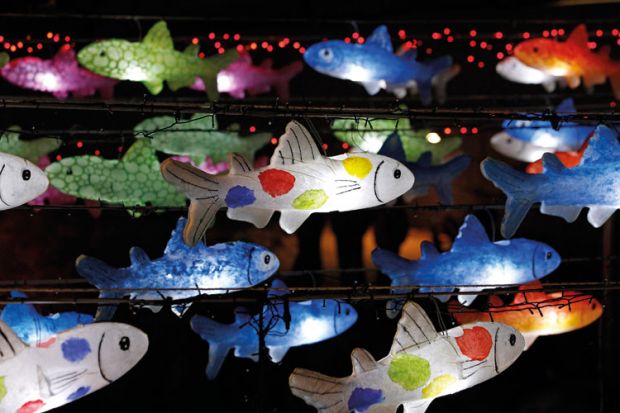Teaching your first university seminar is a testing experience for any novice academic, but for Emilie Roy the situation presented even more of a challenge than for most.
Not only was it the Canadian’s first academic post after gaining her PhD at McMaster University but she was more than 4,000 miles (6,500 kilometres) away from her Ontario alma mater, teaching at a university deep in Morocco’s Atlas mountains.
Roy, now assistant professor of religious studies and anthropology at Al Akhawayn University, Ifrane, about 230 miles from the coastal resort of Casablanca, was also a woman teaching a classroom of imams, many of whom were older clerics.
“I was 30, but I looked a lot younger, so some [of the class] thought that I must have been a lost student,” recalls Roy. “Everyone was a bit surprised when I said I was the teacher.”
Many of Roy’s students had been taught English by women, but none had encountered a female lecturer on their religious studies programme. “There was a big discussion of whether I should be called ‘Ms’ or ‘Mrs’. I suggested, because we were in a professional environment, ‘Dr’ or ‘Professor’,” Roy says.
While few academics will face the same level of culture shock as Roy, many scholars have felt overwhelmed by their new surroundings when taking up an academic post outside their home country. That experience is, of course, nothing new. Lecturers have been adapting to foreign environments since wandering European scholars first converged on the University of Bologna more than 900 years ago.
But it is a growing phenomenon. About half of the estimated 2.2 million researchers working in European Union countries have undertaken some kind of placement outside their home country, according to the EU’s 2013 More2 study. In the UK, there were 51,365 non-UK academic staff in 2013-14, 26 per cent of all academics, up from 17 per cent a decade earlier, according to the Higher Education Statistics Agency.
It is harder to track the number of foreign-born scholars in the US as institutions are not required to report numbers for most disciplines. However, about 610,000 PhD holders in the US are foreign-born – accounting for 27 per cent of all doctorates held in the country from 2005 to 2009. This is almost 40 per cent higher than in 2000, according to an Organisation for Economic Cooperation and Development research paper published in 2013. At postdoctoral level, about 55 per cent of engineering postdocs and 42 per cent of physics postdocs were on temporary visas in 2013, according to the National Center for Science and Engineering Statistics. The largest numbers of international scholars in the US come from China (22 per cent), India (9.4 per cent) and South Korea (9.3 per cent), 2004 figures from the Institute of International Education suggest.
Despite these massive cross-border flows, there has been very little examination of the experiences of the “immigrant professor”, says Charles B. Hutchison, associate professor of education at the University of North Carolina at Charlotte, and the editor of a new book on the subject, Experiences of Immigrant Professors: Challenges, Cross-Cultural Differences, and Lessons for Success.
The Ghana-born academic has gathered 21 studies and personal reflections from overseas academics, giving an insight into the varied personal and professional challenges that they face. These include tales of expatriate academics in Cambodia, efforts to decode the rules of France’s “baffling” university system and Robin Sakamoto’s take on her battle, as a working mother from the US, to break through Japan’s “bamboo ceiling” on her way to becoming dean of Kyorin University’s Faculty of Foreign Studies. (“In my new environment,” she says, “I became illiterate overnight.”)
Hutchison says that academics often “make profound sacrifices” to work overseas and that making such a move often carries a “high personal and emotional cost”. Many of the stories that he has collected detail the lives of itinerant lecturers in the US, with scholars from Africa, Southeast Asia and Spain articulating their struggles to succeed in an often hostile academy.
Scholars describe their difficulties with students unused to interacting with foreign staff, who raise complaints about their tutors’ accent, teaching and rigorous marking style. “Academics face a culture shock when they move to a new country, but there is also the ‘teaching shock’,” explains Hutchison. “That is often the biggest change to handle.”
Managing the behaviour and demands of US students is a particular difficulty for incoming academics, says Hyeyoung Bang, associate professor at the School of Educational Foundations, Leadership and Policy at Bowling Green State University, in Ohio, who is from South Korea. “In Korea, we expect to get respect from students straight away, but that is not always the case in the US,” says Bang. In North America, she adds, “students do not give respect unless it is earned”.
That challenging environment places extra pressure on overseas staff, who are always aware of the power wielded by students via complaints over teaching or class feedback, which can help to determine whether temporary contracts are renewed, she says. “It is already frightening to stand up in front of students, particularly when you are lecturing in English and not in your mother tongue.”

Drawing on interviews that she conducted with seven female professors from China and South Korea, whose ages ranged between 32 and 44, Bang says that staff were shocked by the confrontational attitude encountered in classrooms, with some saying that they felt “bullied” by their students.
“It can be very easy for students to gang up on international staff,” says Bang. “When you are consistently challenged, it can make you feel very humble.” Many contributors to Experiences of Immigrant Professors say that their confidence was knocked. As Michael Takafor Ndemanu, assistant professor in the department of teacher education at the University of Southern Indiana, who emigrated from Cameroon to the US in 2006, puts it, it can be “hard to have robust self-esteem in [an] environment where your prior knowledge is discounted and dishonored”.
Many Southeast Asian professors interviewed by Bang also were shocked by students’ attempts to negotiate grades with their tutors, she says.
“I know this isn’t just happening to international faculty, but I’d never seen anything like this in my country,” she says. “If students are not getting good grades, they are mad [angry],” she adds, saying that interviewees had reported various types of intimidation after failing to award an A or B grade to students. “Student feedback and evaluation is a big part of the teaching and tenure-track system here, so students think they have the power to manipulate you into giving them good grades.”
Those interviewed by Bang and several African academics who contributed to Hutchison’s book raise another recurring theme regarding teaching in the US: complaints about their accent. While students’ views may be justified if classes are unintelligible, complaints are sometimes levelled at overseas tutors with more than a decade of teaching experience, says Peter Nayenga, professor of history at St Cloud State University, in Minnesota, who has taught in the US since fleeing Idi Amin’s regime in Uganda in 1977.
“A fellow immigrant once remarked that even after teaching for 16 years, he still was nervous before going to teach his classes,” says Nayenga. “I was initially disheartened to read some students’ evaluations making remarks such as ‘I do not understand his accent’, ‘he speaks too fast’ or the ‘materials he teaches have no relationship to what I am used to’,” he recalls in Experiences of Immigrant Professors.
Nayenga decided to confront the issue of his non-American accent and African heritage head-on by raising his supposed alien status within the US academy. “I devoted a segment at the beginning of each semester in which I discussed with students what I call ‘misconceptions about Africa’,” he explains. He also talked to students more generally about the provenance of accents and how many prominent nationalised Americans had retained their foreign twang despite living for years in the US.
Kenyan-born Eucabeth Odhiambo, associate professor in teacher education at Shippensburg University, in Pennsylvania, has also faced student complaints over her accent, despite assurances from her colleagues that it was not a problem. While some students complained outright to her head of department, she believes that it also manifested itself in what she describes as “micro-aggressions” in classrooms or on feedback forms.
“I often wondered if I was just being oversensitive…it was only after a couple of years of poor student behaviour towards me and low evaluations that I was convinced there was more to this than just my performance as a teacher,” she explains in one chapter, “Not so fast: navigating the complexities of teaching in an American university as a foreign-born teacher educator”.
Odhiambo decided to take action against “micro-aggressions” that were causing debilitating mental strain, taking notes of classroom incidents and student meetings, and seeking mentoring support from colleagues. While it has not solved the challenges involved in teaching, she says that the “positive psychological effect of this action is incredible”: “I no longer have to keep battling in my mind about what to do – it is one burden released.”
Obed Mfum-Mensah, associate professor in education at Messiah College, a private college in Pennsylvania, has also confronted the issue of his foreignness with his students. “As a ritual for introducing myself at the beginning of each course, I wrote my name on the board and invited students to pronounce my name, which they attempted with difficulty,” says Mfum-Mensah, who has been based in the US and Canada for 19 years. “Afterwards, I mentioned that ‘I am an alien from a distant planet called Ghana’,” he adds in a chapter titled “Negotiating the trilogy of blackness, ‘Africanness,’ and ‘accentness’: a ‘native-alien’ professor’s tale”.
Others have encountered clear prejudice. Ndemanu says that “any image of a professor other than white is still a culture shock to some” and describes being mistaken by one student for a handyman coming to do some repairs to the computer before the professor began his class.

Finding mentors and building support networks are seen as crucial survival tactics by many contributors, but while some academics argue in favour of assertiveness in response to difficulties, others advocate “putting a smile on our faces and being nice no matter what prejudice we encounter”. Many international staff “work twice as hard to disprove negative preconceptions, proactively challenge discrimination and institutional barriers, and use their national origin and experiences as strengths in the classroom”, according to Leonie Brooks, a professor at Towson University in Maryland who was born in Jamaica. Brooks “had the distasteful experience of being informed by disgruntled colleagues at different institutions that the only reason I was hired was because of my race or nationality. Although painful, [such] encounters did not dissuade me from remaining at the institution but, rather, made me more determined to succeed.”
Experiences of Immigrant Professors also offers many arguments in favour of making the significant effort of relocating to another country. For Xavier Coller, professor of sociology at Pablo de Olavide University, in Spain, being taught by overseas professors as a student in the 1980s was a “life-changing” experience. Opening up new worlds for their students, “these unusual professors were practically the functional equivalent of what the internet is today”, he says. Research indicates that being taught by overseas academics can lead to better cross-cultural relations, appreciation of diversity and international perspectives. And, as people at the top of their game, overseas professors “shine for all the groups they inadvertently represent and are likely to change people’s perspectives wherever they migrate”, argues Hutchison.
Of course, when working overseas, cultural differences aren’t felt only in the classroom – they also extend to relationships with colleagues. Bang found that many Southeast Asian staff felt unable to chat with other faculty about their working conditions.
“If you are friends in Asia, you can talk about anything – it is really important to open your heart when talking about things,” she explains. “That’s not the culture in the US – they want to know, but not too much. They don’t want to hear whining.”
That can compound the sense of isolation felt by international scholars, who also face additional bureaucratic pressures, such as those surrounding visas and accommodation, alongside personal issues.
“Negotiating the social and administrative structures can be very difficult, even if you have a perfect grasp of English,” says Hutchison. “One Canadian academic brought his car over the border with him to the US, but the challenges he faced getting it insured and registered made his life horrible,” he recalls.
Obtaining visas and recognition of overseas academic qualifications can consume an unexpectedly large proportion of foreign academics’ time, explains Canadian Scott Kissau, associate professor in foreign language education at North Carolina at Charlotte. In his case, he spent the best part of two months preparing his petition to remain in the US and most of a week tracking down documentation for his state teaching licence. “Cultural similarity and geographical proximity do not necessarily shield foreign-born professors from encountering difficulties in their transition to life and work in the host country,” he writes in Hutchison’s book.
Adapting to the new social environs is another tricky transition faced by internationally mobile staff. For academics with partners and children, settling their families into a new city can be difficult and is further complicated when both spouses are keen to pursue their careers.
“It’s a very difficult issue and not many countries do it, but universities need to think about offering dual careers,” believes Miguel Jorge, lecturer in chemical and process engineering at the University of Strathclyde since 2013, who has held academic posts in the UK, US and his native Portugal. Jorge, whose wife is an experimental engineer in Glasgow, says that he has been fortunate not to work in a different city from his wife, but he thinks that the pressure on families is seldom fully recognised by universities.
For Roy, who reflects upon her time as a “girl professor” in Morocco in Experiences of Immigrant Professors, her university’s isolated location many miles away from Fez, the nearest big city, and the more lively resorts on the Mediterranean, made socialising with other staff, even foreign faculty, difficult. “Foreign professors who wanted to go anywhere had to drive for hours, so you had to make a big commitment to do this,” she told Times Higher Education. “For the first two years in my first job, I was so busy focusing on the university that I had zero social life.”
After adapting to life in Morocco and her workload, she says that she now has more time to spend with friends outside academia. However, as is the case for many immigrant professors, the process has taken time. “After years of fieldwork in West Africa, I thought that I was well-equipped to hit the ground running, but every place is so different that it takes time to figure things out,” she says.
Roy adds that “there is no magic solution to settling in as a foreign lecturer, but I think [that] it’s good to meet as many people as possible when you arrive. That way, when you have 10,000 questions, you can ask different people what to do.” Her observation chimes with Hutchison’s belief that an overseas academic can “expect to live as a student for the rest of his or her life”.
Experiences of Immigrant Professors: Challenges, Cross-Cultural Differences, and Lessons for Success is published on 28 October 2015 by Routledge.
后记
Print headline: Fish out of water




